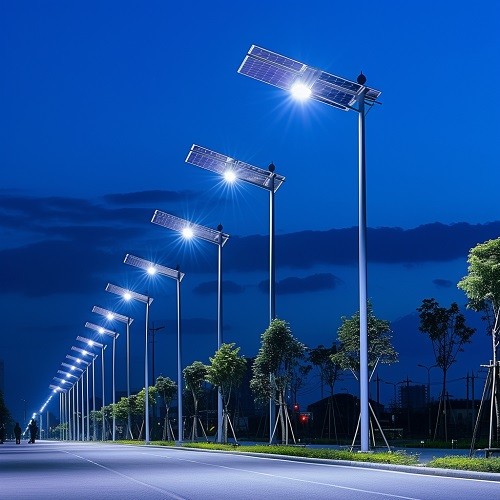Solar street light
-
SITC of Solar Street Light 15W in SursuPanchayat, Angara, Ranchi
A solar street light project involves the installation of solar-powered lighting fixtures along roads, streets, pathways, or other public areas to provide illumination during nighttime hours. These projects utilize solar photovoltaic (PV) technology to generate electricity from sunlight, which is then stored in batteries and used to power energy-efficient LED light fixtures. Here's an overview of solar street light projects:
-
Solar street light systems typically consist of the following components:
-
Solar panels: Photovoltaic panels mounted on top of each lighting fixture absorb sunlight and convert it into electricity.
-
Battery storage: Rechargeable batteries store excess solar energy generated during the day for use during nighttime operation.
-
LED light fixtures: Energy-efficient LED lights are mounted on poles or structures and powered by the stored solar energy.
-
Charge controller: A charge controller regulates the flow of electricity between the solar panels, batteries, and LED lights to prevent overcharging or discharging.
-
Pole and mounting hardware: Poles or structures provide structural support for the solar panels, light fixtures, and other components.
-
Operation and Functionality:
-
During the day, solar panels collect sunlight and convert it into electricity, which is stored in the batteries.
-
As daylight diminishes and ambient light levels decrease, the built-in sensors activate the LED lights, illuminating the surrounding area.
-
The LED lights provide bright, uniform illumination throughout the night, enhancing visibility and safety for pedestrians, motorists, and residents in the vicinity.
-
Depending on the design and configuration, solar street light systems may feature adjustable settings for light intensity, duration, and motion sensing capabilities to optimize energy efficiency and performance.
-
Advantages of Solar Street Light Projects:
-
Energy efficiency: Solar street lights utilize renewable solar energy, reducing reliance on grid electricity and lowering operational costs.
-
Environmental sustainability: By harnessing solar power, these projects help reduce greenhouse gas emissions and contribute to environmental conservation efforts.
-
Cost-effectiveness: While initial installation costs may be higher compared to conventional lighting systems, solar street lights offer long-term savings on electricity bills and maintenance expenses.
-
Remote operation: Solar street lights can be deployed in remote or off-grid locations where access to electricity infrastructure may be limited or impractical.
-
Durability and reliability: Modern solar lighting systems are designed to withstand harsh weather conditions, corrosion, and vandalism, ensuring reliable operation and extended lifespan.
-
Solar street light projects are suitable for a wide range of outdoor lighting applications, including:
-
Roads and highways
-
Residential streets and neighborhoods
-
Parking lots and outdoor parking areas
-
Pathways, walkways, and bike lanes
-
Public parks, plazas, and recreational areas
-
Industrial facilities, warehouses, and construction sites
-
Considerations for Implementation:
-
When planning a solar street light project, it's essential to conduct a thorough site assessment to determine the optimal locations, lighting requirements, and configuration of lighting fixtures.
-
Proper installation, maintenance, and monitoring are critical to ensure the efficient operation and longevity of solar street lights. Regular inspection of components, cleaning of solar panels, and battery maintenance are recommended to optimize performance and reliability.
-
Collaboration with local authorities, stakeholders, and communities is essential to ensure project alignment with urban planning goals, safety standards, and aesthetic considerations.

